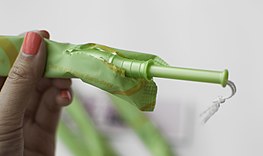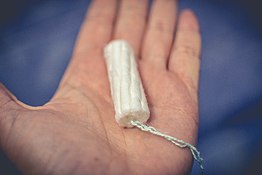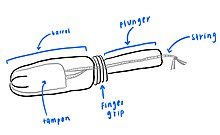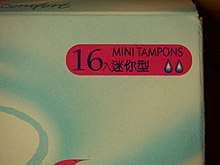Tampon
A tampon is one of the feminine hygiene products designed to absorb the menstrual flow by insertion into the vagina during menstruation. Unlike a pad, it is placed internally, inside of the vaginal canal.[1] Once inserted correctly, a tampon is held in place by the vagina and expands as it soaks up menstrual blood. In addition to menstrual blood, the tampon also absorbs the vagina's natural lubrication and bacteria, which can change the normal pH, increasing the risk of infections from the bacterium Staphylococcus aureus (S. aureus), which can lead to toxic shock syndrome (TSS).[1][2] TSS is a rare, but life-threatening infection that requires immediate medical attention.[3]


The majority of tampons sold are made of rayon, or a blend of rayon and cotton as well as synthetic fibers.[4] Some tampons are made out of organic cotton. Tampons are available in several absorbency ratings. Brands include (but are not limited to) Kotex, Playtex, Tampax, O.B., Cora, Lola, Sustain, Honest Company, Seventh Generation, Solimo, and Rael Tampons.[5]
Several countries regulate tampons as medical devices. In the United States, they are considered to be a Class II medical device by the Food and Drug Administration (FDA).[6] They are sometimes used for hemostasis in surgery.

Design and packaging


Tampon design varies between companies and across product lines in order to offer a variety of applicators, materials and absorbencies.[7] There are two main categories of tampons based on the way of insertion - digital tampons inserted by finger, and applicator tampons. Tampon applicators may be made of plastic or cardboard, and are similar in design to a syringe. The applicator consists of two tubes, an "outer", or barrel, and "inner", or plunger. The outer tube has a smooth surface to aid insertion and sometimes comes with a rounded end that is petaled.[8][9]
Differences exist in the way tampons expand when in use: applicator tampons generally expand axially (increase in length), while digital tampons will expand radially (increase in diameter).[10] Most tampons have a cord or string for removal. The majority of tampons sold are made of rayon, or a blend of rayon and cotton. Organic cotton tampons are made from only 100% cotton.[11] Tampons may also come in scented or unscented varieties.[8]
Absorbency ratings
Tampons are available in several absorbency ratings, which are consistent across manufacturers in the U.S. These differ in the amount of cotton in each product and are measured based on the amount of fluid they are able to absorb.[12] The absorbency rates required by the FDA for manufacturer labeling are listed below:[13]


| FDA Absorbency Ratings | |
|---|---|
| Ranges of absorbency in grams 1 | Corresponding term of absorbency |
| 6 and under | Light absorbency |
| 6 to 9 | Regular absorbency |
| 9 to 12 | Super absorbency |
| 12 to 15 | Super plus absorbency |
| 15 to 18 | Ultra absorbency |
| Above 18 | No term |
Absorbency ratings outside the US may be different. The majority of non-US manufacturers use absorbency rating and Code of Practice recommended by EDANA (European Disposals and Nonwovens Association).
| Droplets | Grams | Alternative size description |
|---|---|---|
| 1 droplet | < 6 | |
| 2 droplets | 6–9 | Mini |
| 3 droplets | 9–12 | Regular |
| 4 droplets | 12–15 | Super |
| 5 droplets | 15–18 | |
| 6 droplets | 18–21 |
A piece of test equipment referred to as a Syngyna (short for synthetic Vagina) is usually used to test absorbency. The machine uses a condom into which the tampon is inserted, and synthetic menstrual fluid is fed into the test chamber.[14]
Labeling
The FDA requires the manufacturer to perform absorbency testing to determine the absorbency rating using the Syngyna method or other methods that are approved by the FDA. The manufacturer is also required to include on the package label the absorbency rating and a comparison to other absorbency ratings as an attempt to help consumers choose the right product and avoid complications of Toxic Shock Syndrome (TSS). In addition, The following statement of association between tampons and Toxic Shock Syndrome (TSS) is required by the FDA to be on the package label as part of the labeling requirements: "Attention: Tampons are associated with Toxic Shock Syndrome (TSS). TSS is a rare but serious disease that may cause death. Read and save the enclosed information."[13]
Such guidelines for package labeling are more lenient when it comes to tampons bought from vending machines. For example, tampons sold in vending machines are not required by the FDA to include labeling such as absorbency ratings or information about Toxic Shock Syndrome (TSS).[13]
Costs
The average woman may use approximately 11,400 tampons in her lifetime (if she uses only tampons rather than other products).[15] Generally, a box of tampons costs can range from $6 to $10 and have 12 to 40 tampons per box. Women use around 9 boxes a year, leading to a total cost between $54 to $90 a year (around $0.20-$0.40 a tampon).[1]
Health aspects
Toxic shock syndrome
Menstrual toxic shock syndrome (mTSS) is a life-threatening disease most commonly caused by infection of superantigen-producing Staphylococcus aureus. The superantigen toxin secreted in S. aureus infections is TSS Toxin-1, or TSST-1. Incidence ranges from 0.03 to 0.50 cases per 100,000 people, with an overall mortality around 8%.[16] mTSS signs and symptoms include fever (greater than or equal to 38.9 °C), rash, desquamation, hypotension (systolic blood pressure less than 90 mmHg), and multi-system organ involvement with at least three systems, such as gastrointestinal complications (vomiting), central nervous system (CNS) effects (disorientation), and myalgia.[17]
Toxic shock syndrome was named by Dr. James K. Todd in 1978.[18] Dr. Philip M. Tierno Jr., Director of Clinical Microbiology and Immunology at the NYU Langone Medical Center, helped determine that tampons were behind toxic shock syndrome (TSS) cases in the early 1980s. Tierno blames the introduction of higher-absorbency tampons made with rayon in 1978, as well as the relatively recent decision by manufacturers to recommend that tampons can be worn overnight, for the surge in cases of toxic shock syndrome.[19] However, a later meta-analysis found that the material composition of tampons is not directly correlated to the incidence of toxic shock syndrome, whereas oxygen and carbon dioxide content of menstrual fluid uptake is associated more strongly.[20][21][22]
In 1982, a liability case called Kehm v. Proctor & Gamble took place, where the family of Patricia Kehm sued Proctor & Gamble for her death on September 6, 1982 from TSS, while using Rely Tampons. The case was the first successful case to sue the company. Proctor & Gamble paid $300,000 in compensatory damages to the Kehm family. This case can be attributed to the increase in regulations and safety protocol testing for current FDA requirements.[2]
Some risk factors identified for developing TSS include recent labor and delivery, tampon use, recent staphylococcus infection, recent surgery, and foreign objects inside the body.[23]
The U.S. Food and Drug Administration suggests the following guidelines for decreasing the risk of contracting TSS when using tampons:[24][25]
- Choose the lowest absorbency needed for one's flow (test of absorbency is approved by FDA)
- Follow package directions and guidelines for insertion and tampon usage (located on box's label)
- Change the tampon at least every 6 to 8 hours or more often if needed
- Alternate usage between tampons and pads
- Avoid tampon usage overnight or when sleeping
- Increase awareness of the warning signs of Toxic Shock Syndrome and other tampon-associated health risks (and remove the tampon as soon as a risk factor is noticed)
The FDA also advises those with a history of TSS not to use tampons and instead turn to other feminine hygiene products to control menstrual flow.[26] Other feminine hygiene products available include pads, menstrual cups, menstrual discs, and reusable period underwear.[1]
Cases of tampon-connected TSS are very rare in the United Kingdom[27][28][29] and United States.[30][31] A controversial study by Tierno found that all-cotton tampons were less likely than rayon tampons to produce the conditions in which TSS can grow.[32] This was done using a direct comparison of 20 brands of tampons, including conventional cotton/rayon tampons and 100% organic cotton tampons.[33] In a series of studies conducted after this initial claim, it was shown that all tampons (regardless of composition) are similar in their effect on TSS and that tampons made with rayon do not have an increased incidence of TSS.[16] Instead, tampons should be selected based on minimum absorbency rating necessary to absorb flow corresponding to the individual.[25]
Sea sponges are also marketed as menstrual hygiene products. A 1980 study by the University of Iowa found that commercially sold sea sponges contained sand, grit, and bacteria. Hence, sea sponges could also potentially cause toxic shock syndrome.[34]
Studies have shown non-significantly higher mean levels of mercury in tampon users compared to non tampon users. No evidence showed an association between tampon use and inflammation biomarkers.[35]
Other considerations
Tampon-drug interactions
There are multiple cases in which the use of tampons may need a medical advice from a healthcare professional. For example, as part of the National Institutes of Health, the U.S. National Library of Medicine and its branch MedilinePlus advise against using tampons while being treated with any of several medications taken by the vaginal route such as vaginal suppositories and creams, as tampons may decrease the absorbance of these drugs by the body. Example of these medications include Clindamycin,[36] Terconazole,[37] Miconazole,[38] Clotrimazole,[39] when used as a vaginal cream or vaginal suppository, as well as Butoconazole Vaginal Cream[40].
Increased risk for infections
According to the American Society for Blood and Marrow Transplantation (ASBMT), tampons may be responsible for an increased risk of infection due to the erosions it causes in the tissue of the cervix and vagina, leaving the skin prone to infections. Thus, ASBMT advises Hematopoietic Cell Transplantation (HCT) recipients against using tampons while undergoing therapy.[41]
Other uses
Clinical use
Tampons are currently being used and tested to restore and/or maintain the normal microbiota of the vagina to treat bacterial vaginosis.[42] Some of these are available to the public but come with disclaimers.[43] The efficacy of the use of these probiotic tampons has not been established.
Tampons have also been used in cases of tooth extraction to reduce post-extraction bleeding.[44]
Tampons are currently being investigated as a possible use to detect endometrial cancer.[45] Endometrial cancer does not currently have effective cancer screening methods if an individual is not showing symptoms.[46] Tampons not only absorb menstrual blood, but also vaginal fluids. The vaginal fluids absorbed in the tampons would also contain the cancerous DNA, and possibly contain precancerous material, allowing for earlier detection of endometrial cancer.[47] Clinical trials are currently being conducted to evaluate the use of tampons as a screening method for early detection of endometrial cancer.
Environment and waste
Appropriate disposal of used tampons is still lacking in many countries. Because the lack of menstrual management practices in some countries, most women dispose their sanitary pads or other menstrual products into domestic solid wastes or garbage bins that eventually becomes part of a solid wastes.[48]
The issue that underlies the governance or implementation of menstrual waste management is how country categorizes menstrual waste. This waste could be considered as a common household waste, hazardous household waste (which will required to be segregated from routine household waste), biomedical waste given amount of blood it contains , or plastic waste given the plastic content in many commercial disposal pads (some only the outer case of the tampon or pads).[49]
Ecological impact varies according to disposal method (whether a tampon is flushed down the toilet or placed in a garbage bin - the latter is the recommended option). Factors such as tampon composition will likewise impact sewage treatment plants or waste processing.[50] The average woman may use approximately 11,400 tampons in her lifetime (if she uses only tampons rather than other products).[15] Tampons are made of cotton, rayon, polyester, polyethylene, polypropylene, and fiber finishes. Aside from the cotton, rayon and fiber finishes, these materials are not bio-degradable. Organic cotton tampons are biodegradable, but must be composted to ensure they break down in a reasonable amount of time. Rayon was found to be more biodegradable than cotton.[51]
Environmentally friendly alternatives to using tampons are the menstrual cup, reusable sanitary pads, menstrual sponges, reusable tampons,[52] and reusable absorbent underwear.[53][54][55]
The Royal Institute of Technology in Stockholm carried out a life cycle assessment (LCA) comparison of the environmental impact of tampons and sanitary pads. They found that the main environmental impact of the products was in fact caused by the processing of raw materials, particularly LDPE (low density polyethylene) – or the plastics used in the backing of pads and tampon applicators, and cellulose production. As production of these plastics requires a lot of energy and creates long-lasting waste, the main impact from the life cycle of these products is fossil fuel use, though the waste produced is significant in its own right.[56]
The menstrual material was disposed according to the type of product, and even based on cultural beliefs. This was done regardless of giving any importance to the location and proper techniques of disposal. In some areas of the world, women dispose of their menstrual waste into pit latrines, as burning and burial were difficult due to limited private space.[48]
History
Women have used tampons during menstruation for thousands of years. In her book Everything You Must Know About Tampons (1981), Nancy Friedman writes, "There is evidence of tampon use throughout history in a multitude of cultures. The oldest printed medical document, Papyrus Ebers, refers to the use of soft papyrus tampons by Egyptian women in the 15th century BCE. Roman women used wool tampons. Women in ancient Japan fashioned tampons out of paper, held them in place with a bandage, and changed them 10 to 12 times a day. Traditional Hawaiian women used the furry part of a native fern called hapu'u; and grasses, mosses and other plants are still used by women in parts of Asia."[57]
R. G. Mayne defined a tampon in 1860 as: "a less inelegant term for the plug, whether made up of portions of rag, sponge, or a silk handkerchief, where plugging the vagina is had recourse to in cases of hemorrhage."[58]
Dr. Earle Haas patented the first modern tampon, Tampax, with the tube-within-a-tube applicator. Gertrude Schulte Tenderich (née Voss) bought the patent rights to her company trademark Tampax and started as a seller, manufacturer, and spokesperson in 1933.[59] Tenderich hired women to manufacture the item and then hired two sales associates to market the product to drugstores in Colorado and Wyoming; and nurses to give public lectures on the benefits of the creation; and was also instrumental in inducing newspapers to run advertisements.
In 1945, Tampax presented a number of studies to prove the safety of tampons. A 1965 study by the Rock Reproductive Clinic stated that the use of tampons "has no physiological or clinical undesired side effects".[18]
During her study of female anatomy, German gynecologist Dr. Judith Esser-Mittag developed a digital-style tampon, which was made to be inserted without an applicator. In the late 1940s, Dr. Carl Hahn, together with Heinz Mittag, worked on the mass production of this tampon. Dr. Hahn sold his company to Johnson and Johnson in 1974.[60]
In the late 1990s, it was found that tampon manufacturers were using dioxin, a known carcinogen, in their rayon bleaching processes. Following this, major commercial tampon brands began switching from dioxin-producing chlorine gas bleaching methods to either elemental “chlorine-free” or “totally chlorine free” bleaching processes.[61]
In the United States, the Tampon Safety and Research Act was introduced to Congress in 1997 as an effort to create transparency between tampon manufacturers and consumers. The bill would mandate the conduct or support of research on the extent to which additives in feminine hygiene products pose any risks to the health of women or to the children of women who use those products during or before the pregnancies involved.[62] Although yet to be passed, the bill has been continually reintroduced, most recently in 2019 as the Robin Danielson Feminine Hygiene Product Safety Act.[63] Data would also be required from manufacturers regarding the presence of dioxins, synthetic fibers, chlorine, and other components (including contaminants and substances used as fragrances, colorants, dyes, and preservatives) in their feminine hygiene products.
Society and culture
Tampon tax
"Tampon tax" refers to tampons' lack of tax exempt status that is often in place for other basic need products. Several political statements have been made in regards to tampon use. In 2000, a 10% goods and services tax (GST) was introduced in Australia. While lubricant, condoms, incontinence pads and numerous medical items were regarded as essential and exempt from the tax, tampons continue to be charged GST. Prior to the introduction of GST, several states also applied a luxury tax to tampons at a higher rate than GST. Specific petitions such as "Axe the Tampon Tax" have been created to oppose this tax, although no change has been made.[64]
In the UK, tampons are subject to value added tax (VAT) at a reduced rate of 5%, as opposed to the standard rate of 20% applied to the vast majority of products sold in the country.[65] The relevant EU legislation was finally changed in 2016.[66] In March 2016, Parliament created legislation to eliminate the tampon VAT.[67] It was expected to go into effect by April 2018 but did not do so.[68] On 3 October 2018, new EU VAT rules that will allow the UK to stop taxing sanitary products were approved by the European Parliament.[69]
In Canada, the federal government has removed the Goods and services tax (GST) and Harmonized sales tax (HST) from tampons and other feminine hygiene products as of July 1, 2015.[70]
In the US, access to menstrual products such as pads and tampons and taxes added on these products, have also been controversial topics especially when it comes to women with low income.[71] Laws for exempting such taxes differ vastly from state to state.[71] The American Civil Liberties Union (ACLU) has published a report discussing these laws and listing the different guidelines followed by institutions such as schools, shelters, and prisons when providing menstrual goods.[71]
The report by ACLU also discusses the case of Kimberly Haven who was a former prisoner that had a hysterectomy after she had experienced Toxic Shock Syndrome (TSS) due to using handmade tampons from toilet paper in prison.[72][71] Her testimony supported a Maryland bill that is intended to increase access of menstrual products for imprisoned women.[71]
Etymology
Historically, the word "tampon" originated from the medieval French word "tampion", meaning a piece of cloth to stop a hole, a stamp, plug, or stopper.[73]
Virginity
Tampon use may stretch or break the hymen of individuals that have never been sexually active.[74] Some cultures regard preservation of the hymen as a supposed evidence of virginity (see also virginity test), which may discourage young women from using tampons.
References
- "Period Products: The Good, the Bad, and the Ugly". UT Health Austin. Retrieved 2020-08-04.
- Vostral, Sharra L. (December 2011). "Rely and Toxic Shock Syndrome: A Technological Health Crisis". The Yale Journal of Biology and Medicine. 84 (4): 447–459. ISSN 0044-0086. PMC 3238331. PMID 22180682.
- "Toxic Shock Syndrome (TSS)". Saint Luke's Health System. Retrieved 2020-08-05.
- CNN, Nadia Kounang. "What's in your pad or tampon?". CNN. Retrieved 2020-07-28.
- Amanda Woerner (2019-09-17). "If You've Been Wearing The Same Tampon Brand Since You Were 13, It Might Be Time To Switch It Up". Women's Health. Retrieved 2020-08-05.
- "Product Classification". www.accessdata.fda.gov. Retrieved 2020-08-03.
- "Tampons". Palo Alto Medical Foundation. Retrieved October 28, 2014.
- "Using Tampons: Facts And Myths". SteadyHealth. Retrieved October 28, 2014.
- Lynda Madaras (8 June 2007). What's Happening to My Body? Book for Girls: Revised Edition. Newmarket Press. pp. 180–. ISBN 978-1-55704-768-7.
- "Pain While Inserting A Tampon". Steadyhealth.com. Retrieved October 28, 2014.
- "Tampons for menstrual hygiene: Modern products with ancient roots" (PDF). Retrieved October 28, 2014.
- "Tampon Absorbency Ratings - Which Tampon is Right for You". Pms.about.com. Retrieved October 28, 2014.
- "CFR - Code of Federal Regulations Title 21". www.accessdata.fda.gov. Retrieved 2020-08-04.
- "Data" (PDF). www.ahpma.co.uk. Retrieved 2019-06-02.
- Nicole, Wendee (March 2014). "A Question for Women's Health: Chemicals in Feminine Hygiene Products and Personal Lubricants". Environmental Health Perspectives. 122 (3): A70–5. doi:10.1289/ehp.122-A70. PMC 3948026. PMID 24583634.
- Berger, Selina; Kunerl, Anika; Wasmuth, Stefan; Tierno, Philip; Wagner, Karoline; Brügger, Jan (September 2019). "Menstrual toxic shock syndrome: case report and systematic review of the literature". The Lancet. Infectious Diseases. 19 (9): e313–e321. doi:10.1016/S1473-3099(19)30041-6. ISSN 1474-4457. PMID 31151811.
- "Toxic Shock Syndrome (Other Than Streptococcal) | 2011 Case Definition". wwwn.cdc.gov. Retrieved 2020-08-05.
- Delaney, Janice; Lupton, Mary Jane; Toth, Emily (1988). The Curse: A Cultural History of Menstruation. University of Illinois Press. ISBN 9780252014529.
- "A new generation faces toxic shock syndrome". The Seattle Times. January 26, 2005.
- Lanes, Stephan F.; Rothman, Kenneth J. (1990). "Tampon absorbency, composition and oxygen content and risk of toxic shock syndrome". Journal of Clinical Epidemiology. 43 (12): 1379–1385. doi:10.1016/0895-4356(90)90105-X. ISSN 0895-4356. PMID 2254775.
- Ross, R. A.; Onderdonk, A. B. (2000). "Production of Toxic Shock Syndrome Toxin 1 by Staphylococcus aureus Requires Both Oxygen and Carbon Dioxide". Infection and Immunity. 68 (9): 5205–5209. doi:10.1128/IAI.68.9.5205-5209.2000. ISSN 0019-9567. PMC 101779. PMID 10948145.
- Schlievert, Patrick M.; Davis, Catherine C. (2020-05-27). "Device-Associated Menstrual Toxic Shock Syndrome". Clinical Microbiology Reviews. 33 (3): e00032–19, /cmr/33/3/CMR.00032–19.atom. doi:10.1128/CMR.00032-19. ISSN 0893-8512. PMC 7254860. PMID 32461307.
- "Toxic shock syndrome: MedlinePlus Medical Encyclopedia". medlineplus.gov. Retrieved 2020-08-05.
- "e-CFR: Title 21: Food and Drugs Administration". Code of Federal Regulations. Section 801.430: User labeling for menstrual tampons: U.S. Food and Drug Administration. Retrieved 11 February 2017.CS1 maint: location (link)
- Commissioner, Office of the (2019-02-09). "The Facts on Tampons—and How to Use Them Safely". FDA.
- "Toxic Shock Syndrome (TSS)". www.hopkinsmedicine.org. Retrieved 2020-07-30.
- Kent, Ellie (2019-02-07). "I nearly died from toxic shock syndrome and never used a tampon". BBC Three. Retrieved 2019-10-19.
- "TSS: Continuing Professional Development". Toxic Shock Syndrome Information Service. 2007-10-01. Retrieved 2019-10-19.
- Mosanya, Lola (2017-02-14). "Recognising the symptoms of toxic shock syndrome saved my life". BBC Newsbeat. Retrieved 2019-10-19.
- "Toxic Shock Syndrome". NORD (National Organization for Rare Disorders). 2015-02-11. Retrieved 2019-10-19.
- "What You Need To Know About Toxic Shock Syndrome". University of Utah Health. 2018-07-02. Retrieved 2019-10-19.
- Tierno, Philip M.; Hanna, Bruce A. (1985-02-01). "Amplification of Toxic Shock Syndrome Toxin-1 by Intravaginal Devices". Contraception. 31 (2): 185–194. doi:10.1016/0010-7824(85)90033-2. ISSN 0010-7824.
- Tierno, Philip M.; Hanna, Bruce A. (1998-03-01). "Viscose Rayon versus Cotton Tampons". The Journal of Infectious Diseases. 177 (3): 824–825. doi:10.1086/517804. ISSN 0022-1899.
- "Ask John".
- Singh, Jessica; Mumford, Sunni L.; Pollack, Anna Z.; Schisterman, Enrique F.; Weisskopf, Marc G.; Navas-Acien, Ana; Kioumourtzoglou, Marianthi-Anna (11 February 2019). "Tampon use, environmental chemicals and oxidative stress in the BioCycle study". Environmental Health: A Global Access Science Source. 18 (1): 11. doi:10.1186/s12940-019-0452-z. ISSN 1476-069X. PMC 6371574. PMID 30744632.
- "Clindamycin Vaginal: MedlinePlus Drug Information". medlineplus.gov. Retrieved 2020-08-05.
- "Terconazole Vaginal Cream, Vaginal Suppositories: MedlinePlus Drug Information". medlineplus.gov. Retrieved 2020-08-05.
- "Miconazole Vaginal: MedlinePlus Drug Information". medlineplus.gov. Retrieved 2020-08-05.
- "Clotrimazole Vaginal: MedlinePlus Drug Information". medlineplus.gov. Retrieved 2020-08-05.
- "Butoconazole Vaginal Cream: MedlinePlus Drug Information". medlineplus.gov. Retrieved 2020-08-05.
- "Guidelines for Preventing Opportunistic Infections Among Hematopoietic Stem Cell Transplant Recipients". www.cdc.gov. Retrieved 2020-08-06.
- Zespoł Ekspertów Polskiego Towarzystwa Ginekologicznego (2012). "Statement of the Polish Gynecological Society Expert Group on the use of ellen probiotic tampon". Ginekol. Pol. (in Polish). 83 (8): 633–8. PMID 23342891.
- "Markets absorbed by probiotic Swedish tampons". The Local. 2009-12-03. Retrieved 2015-06-06.
- Kalantar Motamedi, M H; Navi, F; Shams Koushki, E; Rouhipour, R; Jafari, S M (June 2012). "Hemostatic Tampon to Reduce Bleeding following Tooth Extraction". Iranian Red Crescent Medical Journal. 14 (6): 386–388. ISSN 2074-1804. PMC 3420033. PMID 22924121.
- Fiegl, Heidi; Gattringer, Conny; Widschwendter, Andreas; Schneitter, Alois; Ramoni, Angela; Sarlay, Daniela; Gaugg, Inge; Goebel, Georg; Müller, Hannes M.; Mueller-Holzner, Elisabeth; Marth, Christian (2004-05-01). "Methylated DNA Collected by Tampons—A New Tool to Detect Endometrial Cancer". Cancer Epidemiology and Prevention Biomarkers. 13 (5): 882–888. ISSN 1055-9965. PMID 15159323.
- Matteson, Kristen A.; Robison, Katina; Jacoby, Vanessa L. (2018-09-01). "Opportunities for Early Detection of Endometrial Cancer in Women With Postmenopausal Bleeding". JAMA Internal Medicine. 178 (9): 1222–1223. doi:10.1001/jamainternmed.2018.2819. ISSN 2168-6106.
- "Women's Wellness: Tampon test for endometrial cancer". Retrieved 2020-08-04.
- Kaur, Rajanbir; Kaur, Kanwaljit; Kaur, Rajinder (2018-02-20). "Menstrual Hygiene, Management, and Waste Disposal: Practices and Challenges Faced by Girls/Women of Developing Countries". Journal of Environmental and Public Health. 2018. doi:10.1155/2018/1730964. ISSN 1687-9805. PMC 5838436. PMID 29675047.
- Elledge, Myles F.; Muralidharan, Arundati; Parker, Alison; Ravndal, Kristin T.; Siddiqui, Mariam; Toolaram, Anju P.; Woodward, Katherine P. (November 2018). "Menstrual Hygiene Management and Waste Disposal in Low and Middle Income Countries—A Review of the Literature". International Journal of Environmental Research and Public Health. 15 (11). doi:10.3390/ijerph15112562. ISSN 1661-7827. PMC 6266558. PMID 30445767.
- Rastogi, Nina (2010-03-16). "What's the environmental impact of my period?". Slate.com. Retrieved October 28, 2014.
- Park, Chung Hee; Kang, Yun Kyung; Im, Seung Soon (2004-09-15). "Biodegradability of cellulose fabrics". Journal of Applied Polymer Science. 94 (1): 248–253. doi:10.1002/app.20879. ISSN 1097-4628.
- "How Reusable Tampons Work". Elite Daily.
- Sanghani, Radhika (3 June 2015). "Period nappies: The only new sanitary product in 45 years. Seriously - Telegraph". Telegraph.co.uk.
- Kirstie McCrum (4 June 2015). "Could 'period-proof pants' spell the end for tampons and sanitary towels?". mirror.
- Spinks, Rosie (2015-04-27). "Disposable tampons aren't sustainable, but do women want to talk about it?". the Guardian.
- "The Environmental Impact of Everyday Things". The Chic Ecologist. 2010-04-05.
- Who invented tampons? June 6, 2006 The Straight Dope
- Mayne, R. G. (1860). An Expository Lexicon of the Terms, Ancient and Modern, in Medical and General Science including a Complete Medico-Legal Vocabulary. London: John Churchill. p. 1249.
- "The History of Tampax". tampax.com. Retrieved 2020-08-05.
- "Johnson & Johnson History". Funding Universe. Retrieved 14 March 2014.
- Bobel, Chris (2006-11-02). ""Our Revolution Has Style": Contemporary Menstrual Product Activists "Doing Feminism" in the Third Wave". Sex Roles. 54 (5–6): 331–345. doi:10.1007/s11199-006-9001-7. ISSN 0360-0025.
- Maloney, Carolyn B. (1997-11-14). "H.R.2900 - 105th Congress (1997-1998): Tampon Safety and Research Act of 1997". www.congress.gov. Retrieved 2020-08-03.
- Maloney, Carolyn B. (2019-07-22). "Text - H.R.3865 - 116th Congress (2019-2020): Robin Danielson Feminine Hygiene Product Safety Act of 2019". www.congress.gov. Retrieved 2020-08-03.
- Orr, Aleisha (February 22, 2013). "Tampon tax a 'bloody outrage'". WAtoday. Retrieved October 28, 2014.
- Butterly, Amelia. "Why the 'tampon tax' is here to stay - for a while at least". Newsbeat. BBC. Retrieved 8 September 2015.
- "Deal reached 'to scrap tampon tax'". BBC News. 2016-03-17. Retrieved 2017-10-06.
- Mortimer, Caroline (March 21, 2016). "Tampon tax: David Cameron announces end to vat on sanitary products in House of Commons". The Independent. Retrieved October 2, 2017.
- Larimer, Sarah (January 8, 2016). "The 'tampon tax,' explained". The Washington Post. Archived from the original on December 11, 2016. Retrieved December 10, 2016.
- Nosheena Mobarik (3 October 2018). "Mobarik: UK one step closer to ending the tampon tax". Conservatives in the European Parliament.
- "Federal government taking the tax off tampons and other feminine hygiene products, effective July 1". National Post. 2015-05-28. Retrieved 2018-09-27.
- "The Unequal Price of Periods". American Civil Liberties Union. November 2019. Retrieved 2020-08-05.
- "No tampons in prison? #MeToo helps shine light on issue". AP NEWS. 2018-03-27. Retrieved 2020-08-05.
- "Oxford Dictionaries - Dictionary, Thesaurus, & Grammar".
- Goodyear-Smith, F. A.; Laidlaw, T. M. (1998-06-08). "Can tampon use cause hymen changes in girls who have not had sexual intercourse? A review of the literature". Forensic Science International. 94 (1–2): 147–153. doi:10.1016/s0379-0738(98)00053-x. ISSN 0379-0738. PMID 9670493.
External links
| Wikimedia Commons has media related to Tampon. |